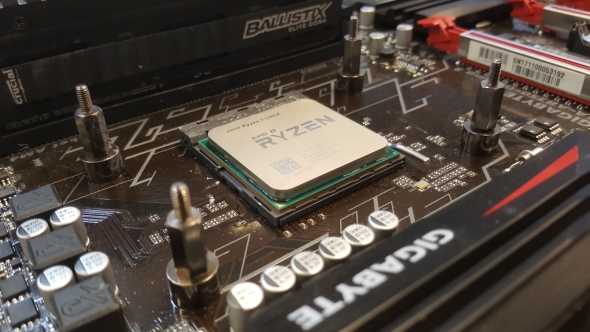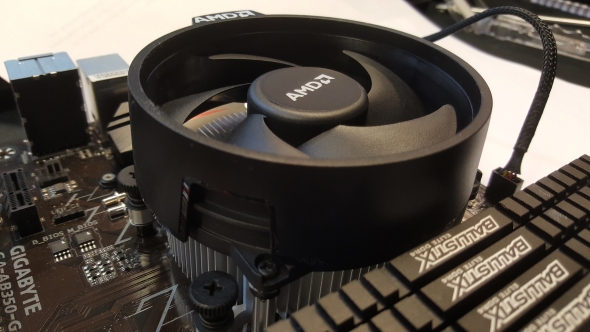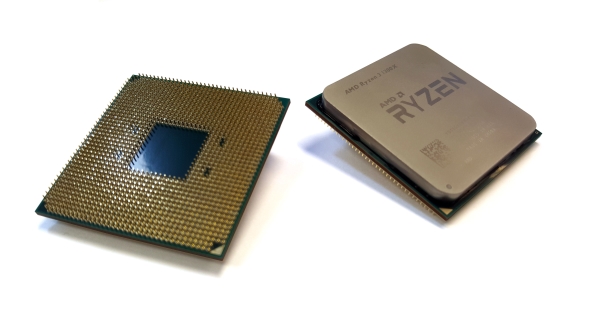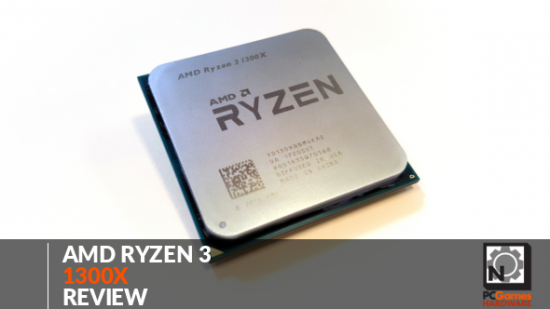The Ryzen 3 processors complete the red team’s inaugural AMD Ryzen CPU lineup, giving us something fresh in the budget sector for the first time in ages. This $129 (£125) Ryzen 3 1300X chip is the top-dog, the head honcho, the numero uno at this end of AMD’s range, and, quite possibly, the best silicon in the budget CPU market as a whole.
The perfect PC comes from the marriage of CPU and GPU, so make sure you pick the best graphics card for your gaming rig.
I’m an unabashed PC tech nerd. I love hardware in all shapes and sizes. But, while I ought to be getting my power cables in a twist over the latest mega-core Intel Core i9 and AMD Threadripper CPUs, it’s actually the new Ryzen 3 processors that have got me really excited. For all the ultra-enthusiast, ~$999 components that litter the virtual shelves of the etailers, they don’t represent things actual humans can buy.
It’s these new slices of silicon, which turn up with a tasty price tag and unprecedented performance, that can make a huge difference to the industry. If you’ve got the capital to spill your wallet on a multi-thousand dollar rig, that’s great, but it’s easy, you just end up buying the most powerful stuff around. Trying to squeeze the most gaming performance out of a properly limited budget… now that’s a task. And when a company creates a new performance paradigm at that low level it can have a more widespread impact than a new Titan.
Click on the jump links to get to the section of your choice.
AMD Ryzen 3 1300X specs

The Ryzen 3 1300X uses the exact same Zen architecture as all the other AMD Ryzen 7 and Ryzen 5 chips we’ve reviewed in this hallowed corner of the interweb, except this time with a few of the attendant cores shut down. As such, it’s got the same twin Zen core complex (CCX) design, each communicating with the other via the Infinity Fabric interconnect, sporting four discrete cores in each CCX module.
But the Ryzen 3 1300X is a resolutely quad-core design, which means AMD have had to disable a pair of Zen cores in each of those CCX modules in order to maintain balance – in other words, the chip is configured in a 2+2 design. And, because it’s a straight quad-core CPU for the budget market, AMD have also disabled simultaneous multi-threading (SMT) too. We can only hope there’s some little techie loophole that pops up allowing us to turn it back on again, but don’t hold your breath.
The 1300X gets a pretty healthy base clockspeed of 3.5GHz, with an all-core Turbo 3.6GHz. And, because of the ‘X’ suffix, this new Ryzen 3 chip also gets a chunky extended frequency range (XFR) boost too. It’s rated up to a maximum of 200MHz extra over its 3.7GHz two-core Turbo, should the installed chip-chiller offer it the headroom, but I was initially sceptical about seeing the 1300X ever hit 3.9GHz as it was seemingly invisible with the previous Ryzen CPUs. That’s not the case here as the XFR frequency regularly makes an appearance in CPU-intensive apps, with one or other of the four cores boosting to 3.9GHz.
Sadly, that’s not the case in any of our test games, with the clockspeed sticking to a resolute 3.6GHz during all of our reference clock testing. What does make a difference in-game, though, is the new AGESA 1.0.0.6 motherboard BIOS update – we now see much broader memory support, with our Crucial kit easily hitting its rated 3,200MHz without problem. That’s not limited to the Ryzen 3 chips either; all of AMD’s Zen-based CPUs now benefit from higher-clocked RAM. That makes for a nice little frame rate boost in-game gratis.
AMD have also been typically generous across their entire Ryzen range, offering overclocking support on all the Zen-based CPUs, depending on the motherboard chipset. So, yeah, don’t get too worried about that 3.9GHz XFR clockspeed not appearing when you’re gaming… overclocking really isn’t that hard.
AMD Ryzen 3 1300X benchmarks

AMD Ryzen 3 1300X performance

We can’t really talk about the performance of the Ryzen 3 1300X without first giving some pricing context. It’s the absolute cheapest of all the CPUs in the benchmarks above, and by a relatively hefty percentage. The closest is the $165 (£152) Core i3 7350K, the first K-series i3, which is able to deliver some impressive gaming frame rates, owing to its supremely high stock clockspeed and overclocking headroom.
But that Intel chip is still a dual-core processor, and we’re past the times where we’d recommend such a CPU even for a budget gaming rig. And it’s more expensive than this genuine AMD quad-core CPU, which has far more impressive processing chops and either as-near-as-makes-no-odds, or just plain better, gaming performance.
Above that it’s the $189 (£170) Ryzen 5 1500X from the same AMD stable, which is a lot more cash and doesn’t really represent that in its relative gaming performance. Because it makes use of AMD’s SMT technology, however, its four cores are able to split into eight simultaneous processing threads, boosting its multi-threaded performance in CPU-intensive applications.
In terms of specs, though, it’s actually the K-series Intel Core i5 which bears the closest technical resemblance to the Ryzen 3 1300X. They’re both resolutely quad-core CPU designs, but the Intel chip has far greater single-threaded performance and overall gaming chops, too. An Intel K-series i5, whether in Skylake or Kaby Lake trim, is nigh-on $100 (£100) more expensive, which is the sort of price differential that would make a massive difference were you to take that cash and drop it on a better graphics card instead.

We’ve also dropped the wonderful Ryzen 5 1600X into the benchmarks too – again, another $100 (£100) more than the new Ryzen 3 – but that’s there to highlight just how much more advanced the AMD chip is compared to what Intel have got sitting at the same price. As we’ve been saying since first dropping it into our test rig, it’s now practically impossible to pretend the Intel Core i5 is worth building your gaming rig around when you can pick up a CPU with three times the thread-count, and essentially the same gaming performance, for the same price.
But what our tests really show is that, in the sub-$200 CPU market, there is precious little to separate the processors on display in terms of gaming performance. As you’d expect, the Core i5 and Ryzen 5 1600X are the frontrunners in that regard, but beneath them you’re really not getting a whole lot more out of the eight-threaded 1500X, or the supremely overclockable i3 7350K, for your money.
In overclocking terms, the Ryzen 3 1300X is solid, if not particularly stunning. We managed to exceed the 3.9GHz XFR rating to deliver an all-core clockspeed of just over 4GHz. That delivers much improved processing performance, almost on par with a stock-clocked K-series i5. It offers some small gaming improvements, too, without being much of an extra burden on the attached cooling. It’s also worth pointing out that was achieved by using the second tier B350 platform, albeit in our pick of the best AMD motherboards around.
AMD Ryzen 3 1300X verdict

So, we now have our favourite budget gaming CPU. AMD have continued their approach of bringing more cores into more affordable price points, giving the 1300X the same core configuration as the pricier Core i5 range of Intel desktop processors. In turn, that means the Ryzen 3 1300X has twice the number of cores as the closest Intel chips and delivers performance either on par with, or greater than, any other CPU in the sub-$200 market.
The Core i5 K-series and Ryzen 5 1600X chips still reign supreme when it comes to overall gaming performance – and we’d still recommend the 12-threaded AMD CPU of the two – but for a bargain gaming build the 1300X is a great little chip. The platform costs make a tangible difference too. You can almost pick up this processor and a quality, overclocking-capable, B350 motherboard for the same price as the Intel i5 CPU on its own.
And that might just give you enough spare cash to level up your choice of graphics card. At this end of the hardware market, a better GPU is going to make a much greater difference to your PC’s gaming performance than a slightly more powerful CPU.
It’s also gratifying to see AMD continuing to improve the Ryzen platform as a whole. The latest AGESA 1.0.0.6 update has delivered more widespread memory compatibility and we experienced none of the teething troubles we had with the Ryzen 5 and 7 launches.
The Ryzen 3 1300X deserves to be the heart of a host of new, low-cost gaming PCs. It delivers more processing performance than equivalent chips in its weight class and has the gaming skills to let your graphics card stretch its silicon legs too. AMD are really nailing the CPU market right now – fingers crossed we’ll see the GPU side hold up their end of the bargain soon too.
